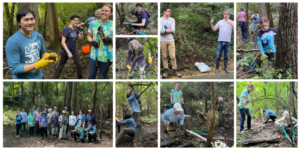A Community of the Land – NCWF’s Public Lands Habitat Restoration Impact

“We abuse land because we regard it as a commodity belonging to us. When we see land as a community to which we belong, we may begin to use it with love and respect.” – Aldo Leopold, A Sand County Almanac
Each one of us possesses a stake in the ownership of our public lands and waters. These lands provide us with priceless natural resources, places for communion and recreation, and opportunities for a retreat from the noise and stress of an urbanized modern world. But – perhaps more importantly – these landscapes offer us both a chance to connect with the natural histories within the places we call home, and a connection to a community of the land – a community to which we all belong.
Unfortunately, the irony of our shared public lands is that they often go unappreciated by the public and are subsequently ignored and even abused. Lands as rich with biotic diversity and natural history require a network of individuals and groups to celebrate and care for them – through advocacy, political action, habitat restoration, increased access, and more.
This is one of the many goalposts of NCWF’s Community Wildlife Chapters. From the mountains to the coast, NCWF Community Wildlife Chapters work to protect, conserve, and restore both public and private lands – allowing others the opportunity to experience the beauty of these shared resources and the wildlife and habitat within them.
So far this year, 796 volunteers have participated in 57 habitat restoration projects, have removed truckloads of invasive plant species, planted 1,006 native trees/shrubs, and removed 40,954 lbs of litter from wildlife habitat.
Though these numbers speak volumes, some critical outcomes from these events and their impact cannot be measured:
- These events provide outdoor spaces for people to establish meaningful connections with wildlife and nature, promoting a deeper understanding and appreciation for the natural world and the life within it.
- The collective efforts of volunteers contribute to the improvement of water and air quality, creating a healthier living environment for everyone, even those outside of their own neighborhoods.
- Restoration work leads to enhanced soil quality, floral diversity, and the creation of vital habitats for various wildlife species.
- By mitigating factors that contribute to flooding, these projects play a crucial role in minimizing the risk of floods and their subsequent damages, ensuring greater resilience for the community as a whole.
- Finally, whether these projects take place within a neighborhood or a local piece of public land, gathering around a shared goal of conservation strengthens communities. They establish a sense of pride in the natural areas within our state, and in the life that flourishes within them.
As co-owners and co-residents of the public lands within North Carolina, we can all follow the example of these devoted volunteers in protecting, restoring, and connecting to wildlife and habitat.
But first – in no particular order of importance – let’s take a look at the Top 10 Public Lands Projects from this past year!
NCWF’s Top 10 Public Lands Habitat Restoration Projects

Big Sweep at Beech Bluffs, Nov 4. Wake County Parks & Rec and Open Space teamed up with students from N.C. State College of Natural Resources and members of South Wake Conservationists to put a dent in a heaping pile of garbage and kick off what will soon be a new Wake County public park. The crew of 18 removed a whopping 15 thousand pounds of trash that included tires, scrap metal, old furniture, a sofa, pipes, metal canisters, old housing materials and much more. Lexi Seal, Student Ambassador for the N.C. State College of Natural Resources had this to say about the event, “College students have huge impacts on the towns and cities in which we reside while attending university, and while most of us try to have a positive effect on our surrounding environments, unfortunately we often contribute to some of the disturbances. Being part of the Beech Bluffs workday put into perspective the extensive time and labor that it takes to clean up thoughtless trash disposal and the habitat destruction that follows. I would recommend that all students participate in at least one eye opening restoration workday to gain a better understanding of the permanence of our actions.”

Fontana Dam Cleanup, Nov 4-6. Volunteers removed more than 45,000 pounds of litter for the 5th annual cleanup. Since 2019, the collaborative has eliminated more than 200,000 pounds of trash from Fontana Lake through volunteer cleanup efforts. Cleanup founder and Governor’s Conservation Acheivement Awardee Brandon Jones says: “One thing that has been cool to see is how many folks are starting to volunteer that have never even been on this lake before. It made sense, in a way, for those of us who live here or spend a substantial amount of time here to pitch in, but to see total strangers coming from surrounding areas just to be part of an event like this that doesn’t benefit them personally in any way… It is so inspiring.” Read more and watch the recap video.

Island Buttonbush Planting, Nov 12. Lake Norman Wildlife Conservationists planted 300 buttonbushes on two Lake Norman islands. The plants will add shelter and food for wildlife and mitigate erosion. Twenty-five volunteers aged 3-70 were there to help the cause.

Shortleaf Pine Tree Planting at Turnipseed Nature Preserve, Jan 31. The North Carolina Wildlife Federation partnered with Wake County Parks, Recreation and Open Space to plant 75 shortleaf pine trees (Pinus echinata) thanks to the help of 32 volunteers. Afterwards, the crew helped tackle the invasive periwinkle (Vinca minor) that has been running rampant throughout the preserve. Ashley Gagnon, Wake County Open Space Technician, had this to say about the event and their partnership with NCWF, “Wake County Open Space’s partnerships with the NC Wildlife Federation have helped us involve the public in vital conservation efforts around our nature preserves. These volunteer workdays demonstrate the importance of maintaining native plant communities and their many benefits to people and wildlife!”

Tire Dump Cleanup, Feb 25. Marvin Area for the Restoration and Sustainability of Wildlife Habitat (MARSH) brought together over 30 volunteers to remove and recycle a whopping 19,450 pounds worth of tires from the McBride Branch wetlands, an area full of wildlife and natural beauty. Over 760 trees will be planted through NCWF’s Clean and Green initiative as a direct result of these efforts.

Lake James Annual Cleanup, March 18. The Lake James Area Wildlife and Nature Society gathered for its annual trash cleanup where 172 participants of all ages removed over 8,000 pounds from both shorelines and roadways near Lake James State Park. Large, bulky items like tires and wood planks were collected and removed, as well as harmful small plastics that can suffocate wildlife.

Earthshare Corporate Earth Day (Cary), April 13. South Wake Conservationists and NCWF, partnering with Hemlock Bluffs Nature Preserve in Cary, hosted sixteen volunteers from Xylem/Sensus for a native plants workday at the park. A large hillside facing the road at the park entrance was transformed into a native plants haven, with approximately 500 plants planted that day. These included little bluestem, pink muhly, beautyberry, coreopsis, purple coneflower, and stokes aster, mixed in with some obedient plant and swamp sunflowers for good measure. Angela Hawkins, Lead Park Attendant at Hemlock Bluffs Nature Preserve, had this to say about the event, “It’s a great opportunity for the public to learn firsthand about healthy ecosystems and why they are so important. I see people become inspired to make choices for their homes and communities that will support our native plants and wildlife.”

Invasive Plant Removal, April 22. A crew of twenty eco-warriors celebrated Earth Day by removing invasive plants such as English ivy, privet, Italian arum, Japanese knotweed, honeysuckle, and Japanese hops from Chantilly Ecological Sanctuary. The event was hosted by the Charlotte Wildlife Stewards in partnership with Wild Ones Charlotte and the NC Native Plant Society. Donna Bolls, President of the Charlotte Wildlife Stewards, had this to say about the event and the work done at Chantilly, “When people get involved in habitat restoration, they become more aware of the issues which leads to more caring about the issues which leads to more action. These folks are left with a sense of accomplishment that often leads them to volunteer for other restoration projects as well as other volunteer opportunities.When volunteers are involved in habitat restoration, I see people who feel they have made a difference, no matter how small or large.”

Bolin Creek Invasive Plant Removal, July 16. NCWF’s newest chapter, the Tri-County Conservationists (Alamance, Orange, Chatham), held their inaugural chapter event. The intrepid crew tackled a much needed invasive removal project along Bolin Creek in Chapel Hill. Despite the intimidating privet and wisteria that plagued the habitat, the workday was characterized by a healthy dose of optimism and genuine comradery among the volunteers. Jessie Miller, Tri-County Conservationists Chapter Leader, had this to say about the event, “volunteers can truly benefit from removing invasives because they can help heal the places they call home, in addition to learning about the world that is just outside their back door! These removals are invigorating, rewarding, and the greatest of goods!”

Sandy Pines Nature Preserve Invasive Removal, July 27. NCWF and Wake County Open Space hosted volunteers at Sandy Pines Nature Preserve in Wendell. The crew removed invasive species, primarily tree of heaven, that have been steadily creeping into the preserve’s meadows. Chase Joyner, Wake County Open Space Technician, had this to say about the event and their partnership with NCWF, “The NC Wildlife Federation has been a great partnership for the Wake County Open Space team. Through our partnership, we’ve been able to make significant progress on a diverse set of initiatives. Having the NCWF team rally volunteers and assist with litter clean ups, invasive plant removals, and native planting events have really helped us in maintaining a clean, beautiful, and healthy ecosystem for our local wildlife and preserve visitors! We’re excited to accomplish further conservation goals through our continued partnership!”
Protecting our public lands and the wildlife within them requires a community of action and impact. Find a Community Wildlife Chapter near you to make a difference for the wildlife and habitat in your community.
Written by:

– Written by Bates Whitaker, NCWF Communications & Marketing Manager

– Tara Moore, NCWF Director of Conservation Partnerships

– Luke Bennett, NCWF Conservation Coordinator

